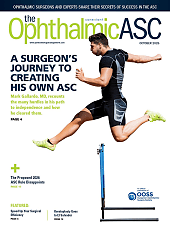As we kick off the 7th year of Retina Minute, I want to take a moment to thank all of our loyal readers and co-authors for your ongoing support. Your dedication to advancing our understanding of retinal diseases makes all the difference.
Recently, I had the opportunity to present exciting new data at the American Uveitis Society Winter Meeting. The focus of my presentation was a real-world study on how the suprachoroidal triamcinolone acetonide injectable suspension (Xipere, Bausch + Lomb) is being used to treat macular edema in patients with uveitis. The study drew on data from the American Academy of Ophthalmology’s IRIS Registry and shed light on both the effectiveness and safety of this treatment option in clinical practice.
What We Set Out to Learn
Macular edema associated with uveitis (UME) can be a challenging condition to manage. Our goal with this study was to better understand how well suprachoroidal triamcinolone acetonide performed in the real world. Specifically, we wanted to answer two key questions:
- How durable is the effect of suprachoroidal triamcinolone acetonide in treating UME over time?
- What are the treatment patterns after patients receive this injection?
In simple terms, we analyzed how long the benefits of a single injection lasted and whether patients needed additional treatments (such as more injections or other steroids) after receiving suprachoroidal triamcinolone acetonide.
How We Conducted the Study
We analyzed data from the IRIS Registry, which includes patient records from across the United States, and linked it to claims data from Komodo Health. This process let us track the real-world use of suprachoroidal triamcinolone acetonide in a large cohort of patients aged 18 years or older, diagnosed with non-infectious UME, and treated with an injection of suprachoroidal triamcinolone acetonide after January 2022.
We studied 929 patients in total, and after applying the inclusion and exclusion criteria, we ended up with a final sample of 785 patients. Slightly more women (55%) than men (45%) were included, 65% of whom were White; 82% had posterior uveitis and 42% had a history of glaucoma or ocular hypertension. These demographics gave us a good sense of the typical patient population treated with suprachoroidal triamcinolone acetonide in the real world, including those at risk for elevated intraocular pressure (IOP) due to steroid use. We followed these patients for 24 weeks after their initial injection to see how they responded to treatment.
Key Findings: Real-World Effectiveness and Safety
One of the most striking findings from the study was how well suprachoroidal triamcinolone acetonide controlled UME without additional treatments:
- 87.7% of eyes did not need any injected or implanted corticosteroid by week 24. This result is nearly identical to those from the Peachtree study, where 86.5% of patients did not need rescue therapy after treatment.
- 75.4% of eyes did not need any form of corticosteroid therapy—whether injected, implanted, or topical—by week 24.
- Only 12.3% of patients required a subsequent injection. Among them, nearly half (46.7%) had a repeat suprachoroidal injection of triamcinolone acetonide.
These results suggest a single injection of suprachoroidal triamcinolone acetonide offers durable relief from UME, with long-lasting effects for most patients.
A common concern when using corticosteroids such as triamcinolone is the risk of increased IOP, especially in patients with a history of glaucoma or ocular hypertension, so we took a closer look at the IOP data for a 48-week period. We found:
- 14.2% of patients had a rise in IOP of at least 10 mm Hg at some point during the study. These elevations occurred at 6, 12, 24, and 48 weeks.
- Of those, only four patients (1.1%) experienced an IOP greater than 25 mm Hg. These cases occurred at 12, 24, and 48 weeks.
- No patients had IOP more than 30 mm Hg.
These findings suggest that, while some patients may experience a rise in IOP, it is relatively low and manageable, even in those with a history of glaucoma or ocular hypertension.
What Do These Findings Mean for Clinical Practice?
Based on these real-world results, suprachoroidal triamcinolone acetonide appears to be a safe, effective, and well-tolerated treatment for UME—even for patients at risk of steroid-induced ocular hypertension. Clinicians should consider following up at 1, 3, 6, and every 3 months thereafter to monitor for any increases in IOP.
Suprachoroidal triamcinolone acetonide should be considered for patients with a history of glaucoma or those at risk for elevated IOP because the incidence of significant IOP elevations is low and the timing of IOP increases is relatively predictable.
This editorial content was supported via unrestricted sponsorship.









